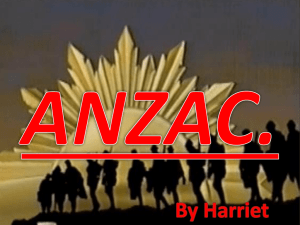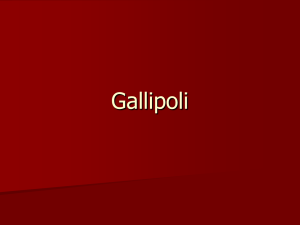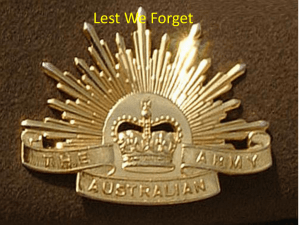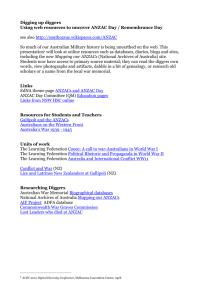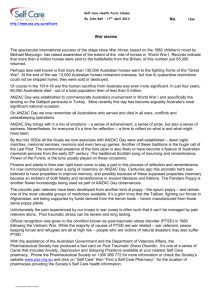Words of remembrance
advertisement
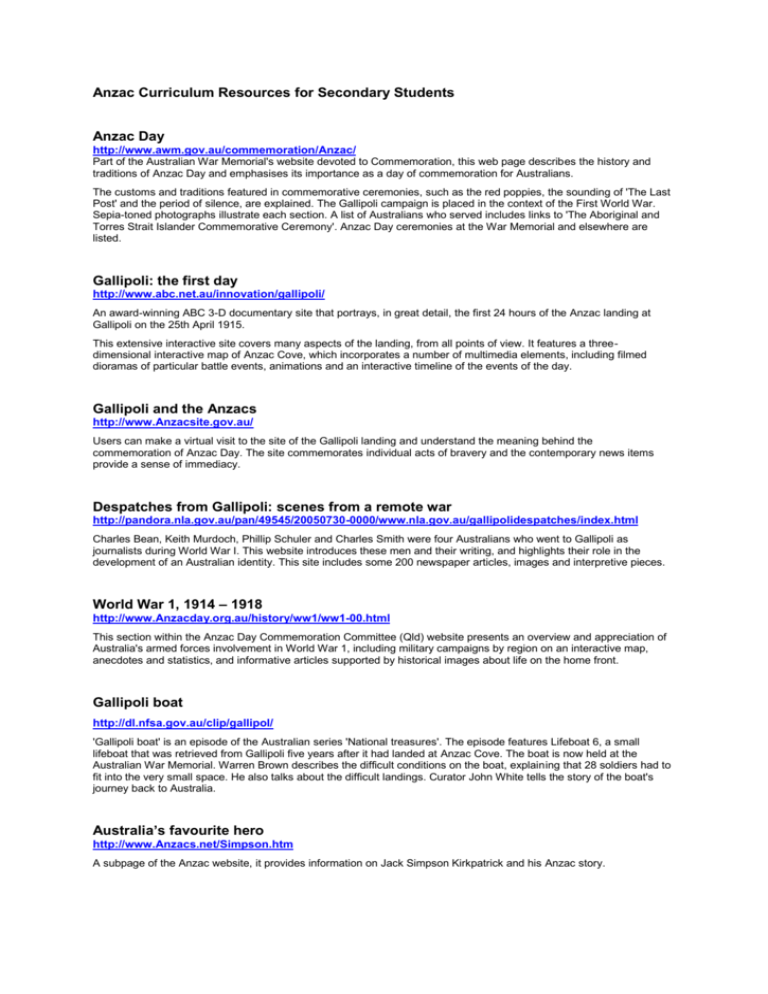
Anzac Curriculum Resources for Secondary Students Anzac Day http://www.awm.gov.au/commemoration/Anzac/ Part of the Australian War Memorial's website devoted to Commemoration, this web page describes the history and traditions of Anzac Day and emphasises its importance as a day of commemoration for Australians. The customs and traditions featured in commemorative ceremonies, such as the red poppies, the sounding of 'The Last Post' and the period of silence, are explained. The Gallipoli campaign is placed in the context of the First World War. Sepia-toned photographs illustrate each section. A list of Australians who served includes links to 'The Aboriginal and Torres Strait Islander Commemorative Ceremony'. Anzac Day ceremonies at the War Memorial and elsewhere are listed. Gallipoli: the first day http://www.abc.net.au/innovation/gallipoli/ An award-winning ABC 3-D documentary site that portrays, in great detail, the first 24 hours of the Anzac landing at Gallipoli on the 25th April 1915. This extensive interactive site covers many aspects of the landing, from all points of view. It features a threedimensional interactive map of Anzac Cove, which incorporates a number of multimedia elements, including filmed dioramas of particular battle events, animations and an interactive timeline of the events of the day. Gallipoli and the Anzacs http://www.Anzacsite.gov.au/ Users can make a virtual visit to the site of the Gallipoli landing and understand the meaning behind the commemoration of Anzac Day. The site commemorates individual acts of bravery and the contemporary news items provide a sense of immediacy. Despatches from Gallipoli: scenes from a remote war http://pandora.nla.gov.au/pan/49545/20050730-0000/www.nla.gov.au/gallipolidespatches/index.html Charles Bean, Keith Murdoch, Phillip Schuler and Charles Smith were four Australians who went to Gallipoli as journalists during World War I. This website introduces these men and their writing, and highlights their role in the development of an Australian identity. This site includes some 200 newspaper articles, images and interpretive pieces. World War 1, 1914 – 1918 http://www.Anzacday.org.au/history/ww1/ww1-00.html This section within the Anzac Day Commemoration Committee (Qld) website presents an overview and appreciation of Australia's armed forces involvement in World War 1, including military campaigns by region on an interactive map, anecdotes and statistics, and informative articles supported by historical images about life on the home front. Gallipoli boat http://dl.nfsa.gov.au/clip/gallipol/ 'Gallipoli boat' is an episode of the Australian series 'National treasures'. The episode features Lifeboat 6, a small lifeboat that was retrieved from Gallipoli five years after it had landed at Anzac Cove. The boat is now held at the Australian War Memorial. Warren Brown describes the difficult conditions on the boat, explaining that 28 soldiers had to fit into the very small space. He also talks about the difficult landings. Curator John White tells the story of the boat's journey back to Australia. Australia’s favourite hero http://www.Anzacs.net/Simpson.htm A subpage of the Anzac website, it provides information on Jack Simpson Kirkpatrick and his Anzac story. Anzac Day 2012 http://www.dva.gov.au/commems_oawg/commemorations/commemorative_events/Anzac_day/Pages/ind ex.aspx The site has been established by the Department of Veterans' Affairs to provide information about Anzac Day. Detail is provided on its history, Australian commemorative services and Anzac Day memorial services at Gallipoli and in France. The historical significance of the Anzac legend and the origins of the Dawn Service are explained. The Gallipoli and Villers-Bretonneux campaigns are described and a link is provided to a special website about Gallipoli. While the information is largely aimed at travellers, there is much of use to schools here. Words of remembrance http://www.Anzacday.org.au/education/tff/rememwords.html This page, focussing on words of remembrance used at Anzac Day ceremonies, is a component of a larger site about Anzac Day. The page includes words from an ancient Greek, a World War I Turkish commander and an English poet. There are links to another section on the website - Traditions, facts and folklore - where other information on Anzac Day is available. Anzac Day http://www.nzhistory.net.nz/war/Anzac-day/introduction New Zealand's participation in the Gallipoli landing is the focus of this site. The significance of Anzac Day, the origin of the term, the memorials and the casualties are vividly described. Biographies, diaries, sound files, paintings and photographs add personal touches to the histories. Emphasis is placed on commemoration ceremonies. This is a very useful site, providing balance to the Australian websites, which naturally focus on Australia's involvement.
